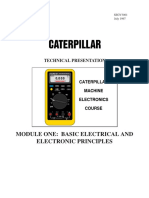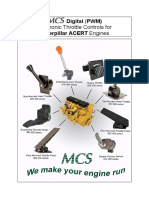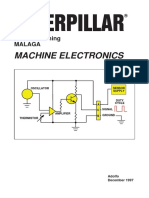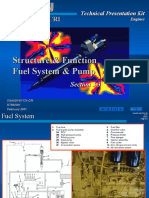Caterpillar Speed Sensor Principles and Operation
Caterpillar Speed Sensor Principles and Operation
Uploaded by
Charles HornCopyright:
Available Formats
Caterpillar Speed Sensor Principles and Operation
Caterpillar Speed Sensor Principles and Operation
Uploaded by
Charles HornCopyright
Available Formats
Share this document
Did you find this document useful?
Is this content inappropriate?
Copyright:
Available Formats
Caterpillar Speed Sensor Principles and Operation
Caterpillar Speed Sensor Principles and Operation
Uploaded by
Charles HornCopyright:
Available Formats
SPEED SENSORS
Basic Operating Principles and Applications
Service Training Update 2008
Speed Sensors General Information
Speed sensors are divided into two classes
Passive (no power required)
VR Variable Reluctance
Active (requires a power source)
Hall Effect
Single (3 wires)
Dual (4 wires)
Current Loop (2 wires)
AMR Anisotropic Magneto Resistance
Packaging differentiate product families
Passive
Thru-mold
Adjustable
Fixed Gap
Overmold
Fixed Gap
Active
Single Hall Effect
Adjustable
Fixed Gap
Slip Head (obsolete)
Dual Hall Effect
Fixed Gap
AMR
Fixed Gap
Speed Sensors Product Families
Passive
Active
Thru-mold
Adjustable Gap
Thru-mold Fixed Gap Over-mold Fixed Gap
Current Loop
Hall Effect
Single Hall Effect Dual Hall Effect
AMR
Passive Sensors
Also known as:
VR (Variable Reluctance)
MagPickup
Pulse Generator
Timing Probe
Crankshaft Position Sensor
General -Passive
Passive sensors do not require any external electrical power
supply.
Output signal is an alternating current.
Wave form is function of the actuator.
Generally, sinusoidal in nature
Voltage and frequency are both proportional to surface speed of
the actuator as it passes the sensors pole piece.
Product Description -Passive
Non-contact transducer that converts mechanical
motion into electrical signal
Actuator must be ferro-magnetic material
Carbon steel, magnetic stainless steel, or iron
Commonly used actuators include
Gears, slotted discs, shafts with keyways
No moving parts
Shell
Lead
Wires
Molding
Material
Magnet
Pole
Piece
Coil
Principle of Operation -Passive
Permanent magnetic field applied through coil of wire.
Figures below illustrate how the magnetic field changes by the
approach and passing of a gear tooth, e.g. flux discontinuity
Change in the magnetic field produces a voltage across the coil
Just like on an electric generator
Voltage and frequency are directly proportional to target speed.
Low Reluctance Position
High Reluctance Position
Principle of Operation Passive (cont.)
All physical space exhibits a degree of opposition to the passage of
magnetic flux. This is called Reluctance.
Ferrous materials provide low reluctance path
Air provides high reluctance path
In a Variable Reluctance (VR) system, the reluctance of the magnetic flux is
varied.
The path loops through a coil of wire, which generates a voltageat the
terminals of the coil that is exactly proportional to the rate of change of
magnetic flux.
Relationship:
dt
d
N e
=
e =voltage generated
N =number of turns of wire in the coil
=magnetic flux
dt
d
=time rate of change of the flux
Principle of Operation Passive (cont.)
The flux is provided by a permanent magnet.
The flux is directed through the coil by a ferrous core called a
pole piece.
Most targets are spur gears.
As a tooth of a gear comes in alignment with the pole piece, the
reluctance decreases so the magnetic flux increases.
There are many factors which affect the voltage level, wave
shape, and frequency:
Strength of magnet
Shape of target
Number of turns of wire in the coil
Speed of target
Air gap between pole piece and target
Permeability of target
Load impedance
Timing and Position Sensing -Passive
X
0
TARGET
X = 0
X(-) X(+)
VR
SENSOR
(PASSIVE)
GEAR
TOOTH
X = 0
+
-
VOLTS
Zero crossing is
in the center of
the tooth!
Active Sensors
Hall Effect
Single (3-wires)
Dual (4-wires)
Current Loop (2-wires)
AMR
General -Active
Active sensors requirean external electrical power supply.
Output signal is an alternating voltage.
Wave form is function of the actuator.
Square wave output
Frequency is both proportional to surface speed of the actuator as it passes
the sensors tip.
Zero speed detection
Product Description Active Hall Effect
Single Hall Effect sensors have 1 Hall element.
Dual Hall Effect sensors have 2 Hall elements.
Each element is spaced to provide two signals that are 90 apart.
Rotor has to be designed to fit hall cell spacing
This allow direction detection
Signal A leads Signal B or vice-versa
Current Loop
Draws 4-8 mA in one state
Draws 12-16 mA in other state
State depends on direction of rotation of target
In one direction, draws low current over tooth & high over valley
In reverse direction, draws high current over tooth & low over valley
Allows diagnostics to detect if sensor is connected
Principle of Operation Active Hall Effect
A Hall element is semiconductor that outputs a voltage
proportional to magnetic flux density.
Cats Hall effect sensors have a permanent magnet.
This provides a magnetic flux field.
A bias voltage is applied across the Hall element.
Current through the Hall element varies with changes in flux
density
When a gear tooth passes in front of the sensor, the flux density from the
permanent magnet changes similar to that of a VR sensor.
This creates a differential voltage across the semiconductor.
The differential voltage is directly proportional to the rate of change of
magnetic flux.
The differential voltage is amplified, filter, and then various peak detection
schemes are used to determine a tooth edge. All of this is donewith an
integrated circuit (IC).
Principle of Operation Active/Hall Effect
Vs+
Vo+
Vo-
Vs-
H
Hall Element
I
Vo
H
Z
B
v
I
H
V
Current in silicon sensor
Perpendicular Magnetic Field
Timing and Position Sensing -Active
Vsupply - 1V max
0 - 1V max
SIGNAL A
SIGNAL B
DUTY CYCLE & PHASE
ANGLE DEPENDANT ON
TARGET PROFILE
TARGET
Signal edge
is at the
tooth edge
Current Loop Hall Effect Speed Sensor
2 wires
Fewer wires means better harness reliability
Diagnostics - ability to detect if the sensor is connected or not
Detects speed and direction
Lowest cost speed sensor in our product line
Requires ECM input circuitry currently available on A4E2
2-Wire Current Loop System
ECM
SENSOR
Ion
OUTPUT
VOLTAGE
SIGNAL
I
LO
=I
OFF
I
OFF
I
HL
=I
OFF
- I
ON
Product Families -Passive
Thru-mold
Sensor has an external metal housing.
During manufacturing, nylon is injected throughthe housing to mold over the magnet and
coil; hence, thru-mold.
High Output
Lower accuracy
5/8-18, -16, M18x1.5 threads
Low Output
Higher accuracy
5/8-18, -16, M16x1.5threads
Pigtail
Fixed gap
Adjustable w/ jam nut NOT RECOMMENDED FOR NEW DESIGNS
Overmold
Injection molded nylon directly over the magnet and coil; hence, overmold.
High Gain Output
Lower accuracy
Low Gain Output
Higher accuracy
Bolt-n-go
Applications -Passive
Low Gain Output Speed Sensors
High position accuracy
Lower output voltage
Typical applications
Crank
Timing applications
TC, TIS, and intermediate transmission speed sensors
High Gain Output Speed Sensors
Less accuracy in position
Higher output voltage, i.e. lower RPM detection
Typical applications
CAM
TOS
Key Characteristics -Passive
Output voltage decreases with decrease of RPM
Output voltage decreases with increase of air gap
2.5 2.0 1.5 1.0 0.5
10
8
6
4
2
0
air gap
P
e
a
k
t
o
P
e
a
k
2
50
100
150
set speed
25C
Product Families Active/Hall Effect
Single Hall Effect
One Hall cell
One output
3-wires
Dual Hall Effect
Two Hall cells
Quadrature output
Phase shift indicates direction
4-wires (power, return, two signals)
Current loop dual Hall effect
One Hall cell
Requires current source be provided by ECM
Polarity change indicates direction
2-wires
Applications -Active
Used where zero speed or near-zero speed
detection is required.
Transmission Output Speed
Traction Control Systems
Steering
Speed / Timing
Perkins compact common rail
LEC engines
Century Propulsion Motor
Key Characteristics -Active
Tooth profile
Engines edge accuracy
Transmissions duty
cycle
B C
A
A =3 MIN TOOTH HEIGHT
B =2.5 OR 3 MIN TOOTH WIDTH
C =B TOOTH SPACING
D =6 OR 10 MIN GEAR THICKNESS
ACTUAL VALUES ARE SENSOR AND
APPLICATION DEPENDENT
D
Active/Hall Effect vsPassive
Passive
Speed Range
Low Output 200 Hz 45 kHz typ
High Output 50 Hz 15 kHz typ
Application dependent
Air Gap
0.5mm min
Application dependent
Seal
Thru-mold not sealed
Overmold5 psi
Direction
Requires 2 sensors located 90 degrees
electrically apart
Sensors Housing material
Thru-mold
Aluminum
SST
Overmold
Nylon
Active Hall Effect
Speed Range
0 15 kHz
Application dependent
Air Gap
0.5mm min.
Application dependent
Seal
100-150 psi
Direction
Dual Hall Effect
2-wire
Phase shift is application dependent
Sensors Housing material
Brass
SST
Nylon
Anisotropic Magneto Resistance -AMR
AMR presents a new opportunity to achieve
higher speed resolution than previously available
at Cat
Two levels of resolution
1x: 96 ppr (pulses per revolution)
8x: 768 ppr
Excellent duty cycle & phase shift accuracy
Air gap performance >2x hall effect
Zero speed detection
Anisotropic Magneto Resistance -AMR
Permalloy thin film technology
2-Part Encoder
Hi/Lo Resolution Sensor
Magnetic Ring
AMR Functional Description
AMR (Anisotropic Magneto Resistance) occurs in thin, ferrous films.
Preferred axis of magnetization is in the long direction.
External field (Hy) applied perpendicular to the long axis causes the
magnetization vector (M) to rotate through the angle ().
Resistance of the strip of material changes with the angle of the
magnetic field.
M
Hy
Ix
R = (1 - COS
2
)Rmax
AMR measures
magnetic angle
Ring Magnet
Acts similar to teeth on a rotor
VALLEY
TOOTH
Rotor
N S N
N S S
Cross Sections
Ring magnet
emulates
traditional rotor
AMR Ring Magnet Encoder Design
Cats hall effect sensors contain a magnet to back bias the hall cell
Ferrous rotor passes in front of sensor interrupting the magnetic field
AMR senses a magnetic ring
Magnetic poles rotate in front of the sensor
Magnetic poles
emulate rotors teeth
DHP w/ Rotor
DHP Rotor vs AMR Ring
AMR w/ Magnetic Ring
AMR Advantage
With hall effect, you get one pulse
for each tooth/valley or pole pair.
AMR outputs 2 Pulses for every
pole pair
Due to cosine square function of
angle to sensor
Allows bigger magnetic poles for
same resolution of ppr
Bigger magnets means stronger
magnets
Increases air gap performance
R = (1 - COS
2
)Rmax
Sensor
Magnet Rotation
0 1 2 3 4 5 6
FluxDensity resistance
Wider air gap
performance than
hall effect
You might also like
- Turbovisory InstrumentsDocument21 pagesTurbovisory InstrumentsSupratim Pal100% (7)
- Servo Controller - SIL Operation Manual - CATDocument50 pagesServo Controller - SIL Operation Manual - CATEdison Pfoccori BarrionuevoNo ratings yet
- Cat 12 12v Electic TrainingDocument26 pagesCat 12 12v Electic TrainingZenaki Kurniawan100% (2)
- Hydraulic and Braking 777GDocument28 pagesHydraulic and Braking 777GDaniel Pinheiro100% (3)
- 2016 TMI TrainingDocument23 pages2016 TMI TrainingJuan Carlos Gomez Valderrama0% (1)
- Hydraulic Fan Student Booklet EngDocument16 pagesHydraulic Fan Student Booklet Engali67% (3)
- Seg V 3004 Electric As ChemDocument27 pagesSeg V 3004 Electric As ChemJonathan segovia100% (1)
- Seg V 3001 Electronic PrinciplesDocument71 pagesSeg V 3001 Electronic PrinciplesJonathan segovia100% (2)
- CAT 01 Hydraulic Fundamental Student GuideDocument30 pagesCAT 01 Hydraulic Fundamental Student GuideChristianSutanto100% (1)
- LS PumpDocument18 pagesLS PumpKadir Koray BozyelNo ratings yet
- 007 - Cat-6060 - Travel SystemDocument47 pages007 - Cat-6060 - Travel SystemJorby Cuadros100% (2)
- Tractor D10T PDFDocument213 pagesTractor D10T PDFCarlos Alberto Alvarado Loayza100% (2)
- Service Training Malaga 365C & 385C Hydraulic Excavators: Francis Apr 12Document30 pagesService Training Malaga 365C & 385C Hydraulic Excavators: Francis Apr 12ait mimouneNo ratings yet
- CAT ACERT Throttle TypesDocument10 pagesCAT ACERT Throttle TypesDarshan MakwanaNo ratings yet
- Electronically Controlled Transmission System: Track-Type TractorsDocument51 pagesElectronically Controlled Transmission System: Track-Type TractorsFrancisco Alvarado HuenquiaoNo ratings yet
- CAT-ENGINES Presentation 1Document107 pagesCAT-ENGINES Presentation 1Mohamed Saied100% (4)
- 2 PDFDocument9 pages2 PDFRicardo OjedaNo ratings yet
- Basicele Electriciadad y SensoresDocument41 pagesBasicele Electriciadad y SensoresCarcaustoCatt Benk100% (3)
- ElectronicComponent INPUT, OUPUTDocument48 pagesElectronicComponent INPUT, OUPUTtaller avansys100% (4)
- TMI Training Guide OCT2008Document50 pagesTMI Training Guide OCT2008Edwin Julcamoro Aquino100% (3)
- Cat Et TrainingDocument35 pagesCat Et Trainingkarer61088No ratings yet
- Service Training: 793D (FDB) Off-Highway TrucksDocument52 pagesService Training: 793D (FDB) Off-Highway TrucksRolando Taco Chise100% (1)
- 07.0 CMS - SystemDocument31 pages07.0 CMS - SystemSandoval Ramos Eddy100% (1)
- Testing & Adjusting PW200/ 220-7Document13 pagesTesting & Adjusting PW200/ 220-7Teknik Makina100% (2)
- SESV1661Document128 pagesSESV1661Yapi Yapi100% (3)
- Cat Hydraulic Systems Management GuideDocument16 pagesCat Hydraulic Systems Management GuideSetiawan Tuhu BasukiNo ratings yet
- Sensores 3500B EUIDocument32 pagesSensores 3500B EUICesar Ego-Aguirre Calderon100% (5)
- 004 - Cat-6060 - Engine and Pump Drive - Cat 3512CDocument28 pages004 - Cat-6060 - Engine and Pump Drive - Cat 3512CJorby CuadrosNo ratings yet
- 777F MG MotorDocument121 pages777F MG MotorDenerMendozaLayza100% (3)
- 010 6060 RH340B Swing System CATDocument34 pages010 6060 RH340B Swing System CATsubramani SrinivasanNo ratings yet
- PC600-8 Training - 23137Document45 pagesPC600-8 Training - 23137hcliffordpa100% (4)
- Travel Systems - 7Document59 pagesTravel Systems - 7اياد القباطيNo ratings yet
- Over The Road Engine Service TrainingDocument318 pagesOver The Road Engine Service Trainingibrahem100% (3)
- Braking R2900 PDFDocument56 pagesBraking R2900 PDFSintia Yuli Ponce Aguirre100% (1)
- Starting Charging SystemDocument110 pagesStarting Charging SystemFiza Ilmi100% (2)
- 008 - RH120E - Travel SystemDocument27 pages008 - RH120E - Travel SystemOsvaldo UrbanoNo ratings yet
- Structure & Function ECM & ControlsDocument32 pagesStructure & Function ECM & ControlsVik100% (1)
- Serv1852 02 TXT6Document39 pagesServ1852 02 TXT6Mahmoud MohsenNo ratings yet
- Main Pump (Flow) - Test - Constant Horsepower Flow ControlDocument14 pagesMain Pump (Flow) - Test - Constant Horsepower Flow Controlmekanicobucaro100% (2)
- Global Service Learning: M325D MH / M325D L MH Material HandlersDocument52 pagesGlobal Service Learning: M325D MH / M325D L MH Material Handlersanon_828943220100% (2)
- Power Train: SERV1817 - 131 - Text Reference 04/06Document105 pagesPower Train: SERV1817 - 131 - Text Reference 04/06Wesley Gonzalo Yupanqui100% (1)
- Elect Sect01Document113 pagesElect Sect01Luis Eduardo Corzo Enriquez100% (5)
- Structure & Function Fuel System & PumpDocument40 pagesStructure & Function Fuel System & PumpVikNo ratings yet
- Diesel QSC8.3 GEM DisplayDocument48 pagesDiesel QSC8.3 GEM Displayedwin100% (4)
- Steering Priority Valve: Flow To ImplementsDocument19 pagesSteering Priority Valve: Flow To ImplementsAnonymous M28U3D100% (2)
- Qdoc - Tips Caterpillar 246c 256cDocument98 pagesQdoc - Tips Caterpillar 246c 256cloxibknNo ratings yet
- Course Engine Control Caterpillar 992g Wheel Loader Components Operation PDFDocument23 pagesCourse Engine Control Caterpillar 992g Wheel Loader Components Operation PDFBruno Cecatto100% (2)
- Caterpillar Cat 16H NA Motor Grader (Prefix 6ZJ) Service Repair Manual (6ZJ00001 and Up)Document27 pagesCaterpillar Cat 16H NA Motor Grader (Prefix 6ZJ) Service Repair Manual (6ZJ00001 and Up)kfm8seuudu100% (1)
- 004 - CAT-6040 - RH170B - Engine + Pump DriveDocument32 pages004 - CAT-6040 - RH170B - Engine + Pump DriveJorby Cuadros100% (1)
- Cursos de Meui Eui HeuiDocument318 pagesCursos de Meui Eui HeuiLaboratoriodiesel Tachira Ca100% (8)
- Diagnostico y TroubleshootingDocument40 pagesDiagnostico y Troubleshootinggabriel pacovilca arhuata100% (2)
- 777D - ARC Control Solenoid FailureDocument2 pages777D - ARC Control Solenoid FailureDany LeaNo ratings yet
- H-Series Motor Graders: Slide/Text ReferenceDocument39 pagesH-Series Motor Graders: Slide/Text ReferenceVictorDjChiqueCastillo100% (1)
- ENSC 387 Sensors and ActuatorsDocument117 pagesENSC 387 Sensors and ActuatorsMajed KawamNo ratings yet
- Tong TesterDocument9 pagesTong Testeranilakash442No ratings yet
- Tong TesterDocument10 pagesTong TesterGanesh Kumar Naidu100% (1)
- MSD Module 2Document98 pagesMSD Module 2arvind valentinoNo ratings yet
- Ies Electronics PaperDocument26 pagesIes Electronics PaperArchana TripathiNo ratings yet
- Static RelaysDocument89 pagesStatic RelaysAnonymous DbmKEDxNo ratings yet
- Unit 2 Overview of Sensors, Transducers and Their Characteristics SpecificationsDocument87 pagesUnit 2 Overview of Sensors, Transducers and Their Characteristics SpecificationsSahilNo ratings yet



























































